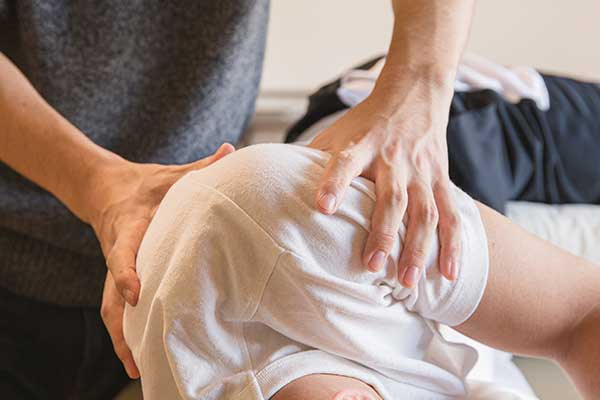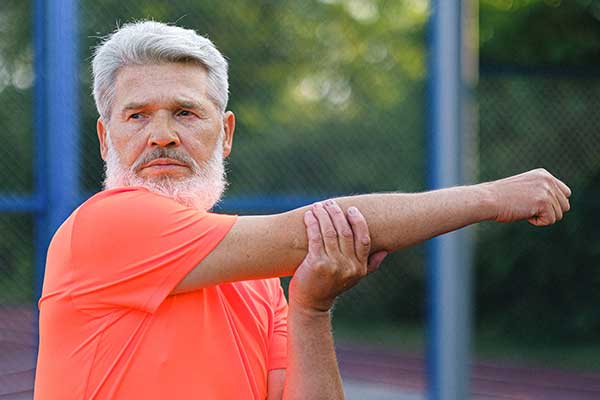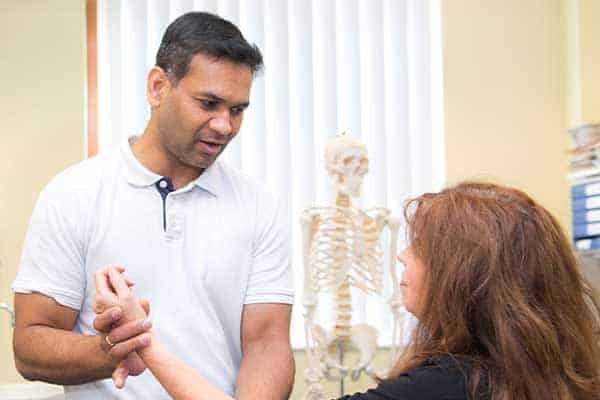A frozen shoulder is a condition that causes pain and loss of movement in your shoulder joint.
What causes a frozen shoulder?
Your shoulder joint is mostly made up of a ball at the top of your arm bone and a socket on the outer side of your shoulder blade. This is held together by a ‘capsule’ of tissue that normally allows you a great range of movement.
With a frozen shoulder, the capsule becomes thicker or tighter, causing stiffness and restricted movement in the joint. The nerves also become very painful.
A primary, or idiopathic, frozen shoulder develops for no apparent reason, although age may be a factor as it is more common in people over 40.
A secondary frozen shoulder is linked to an event such as an injury or surgery, or to other conditions, such as diabetes or cardiovascular disease.
What are the symptoms of a frozen shoulder?
For most people:
- You experience pain in your shoulder that develops gradually but can become severe.
- You feel pain, stiffness and restricted movement when reaching up, behind or to the side.
For some people:
- The pain often extends down the arm to your elbow.
- You may get a feeling that your arm has stuck in position.
- You may experience pain at night that disturbs your sleep.
How is a frozen shoulder diagnosed?
If you think you have a frozen shoulder, you should seek an assessment from a GP or physiotherapist without delay.
What are the treatment options for a frozen shoulder?
It is very important to manage the pain, right from the start, as this will help you to maintain your general health and wellbeing. Talk to your GP or pharmacist about suitable pain medication.
Your healthcare professionals may recommend injections to help with pain relief. Steroids (corticosteroids) are often used, combined with analgesics (painkillers). Other types of injection therapy may also be offered.
While it is important to remain as active as possible, it is not advisable to perform any strenuous shoulder exercises until you are advised to do so by your GP or physiotherapist.
Once you have started to manage your pain levels, you can gradually build up a programme of simple exercises to preserve or restore mobility and strength in your shoulder. Always stop if your pain increases. Physiotherapy will also be a useful option at this stage.
For people who do not respond to other treatments, surgery may be considered.
What is the prognosis (outlook) for a frozen shoulder?
It can take two years or more to recover from a frozen shoulder. However, it is unlikely that the severe pain will last this long.
In some cases, symptoms can linger for longer.
How can I prevent recurrence of a frozen shoulder?
Keeping healthy and active is important. Smoking has also been identified as a risk factor for developing a frozen shoulder, so you should ask for advice about quitting.
Recommended exercises (click to expand):
Puppy dog
- Start on all fours, with your shoulders above your hands and your hips above your knees.
- Carefully walk your hands forward and lower your chest towards the floor. Keep your hips lifted.
- As you extend your arms, allow your head and chest to drop down to the floor.
- If it is uncomfortable to lower your head and chest all the way to the floor, you could place a block or rolled up towel underneath your forehead to lessen the stretch.
- Let your shoulders slide back towards your hips, not hunch up towards your ears.
Wall press up
- Face a wall and stand up straight, then take one step back.
- Place your hands flat against the wall, with your arms around shoulder height and your hands slightly wider than your shoulders.
- Tighten your buttock muscles.
- Keeping your body in a straight line from your feet to the top of your head, bend your elbows and move your chest towards the wall.
- Straighten your arms again to lift your chest away from the wall.
- Repeat this exercise.
Isometric shoulder rotation
- Sit or stand against a wall with your affected arm by your side, side-on to the wall,
- Bend your elbow to 90 degrees and place the back of your wrist against the wall.
- Press your wrist against the wall as though turning your forearm outwards.
- Hold this position.
- Relax and repeat.
Table stretch
- Sit in a chair facing a table, with the table about an arm’s length away.
- Place your hands on the table (you might want to place a cloth under your hands to aid their movement).
- Steadily extend your arms away from you, leaning forward at the waist and lowering your head between your shoulders.
- Be careful not to tense your shoulders. Keep your arms relaxed throughout.
- Stretch out as far as you can and hold this position.
- Return to the starting position, relax and repeat.
Superior capsule stretch
- Sitting upright in a chair, or standing, place a rolled-up towel underneath the upper part of your affected arm and clamp it against your body.
- Bending your affected arm, bring the forearm of this arm across your chest and take hold of the wrist with your other hand.
- Pull your arm across your body until you feel the top of your shoulder stretching.
- Hold this position, then relax and repeat.
Sleeper stretch
- Lie on your affected side with the affected shoulder underneath you.
- Hold the affected arm out in front of you, with the elbow bent at 90 degrees and the fingers pointing at the ceiling.
- Place your other hand on the back of your wrist and push down to rotate the forearm towards the floor, making sure you do not hunch your shoulders.
- Hold this stretch, then relax and repeat.

How to get referred
Find out how to get referred to Practice Plus Group MSK & Diagnostics for NHS treatment.




